Chicago, my favorite city in the U.S., feels like a charming small town with towering buildings. It's a city that never fails to impress, and despite not being an architecture expert, I’m always captivated by its design. I’ll never quite understand why so many new buildings are so uninspired—do people not care anymore? But I digress.
I recently visited Chicago for my nephew’s wedding, which was a blast, but what made it even more special was sharing the experience with family. My son flew in from Los Angeles, and my Brazilian relatives—my cousin, his wife, their daughter, and her husband—joined us too. In between wedding festivities, we took an unforgettable lake and river architecture tour.
What truly sets Chicago apart is its relationship with water. The Chicago River cuts through the city, and Lake Michigan forms its eastern border, creating a breathtaking blend of urban design and natural beauty. The lake and river add a cool breeze and expansive vistas, making you feel like you’re in a coastal town rather than a bustling metropolis.
Highlights of the architecture tour
I’ll confess, the tour was a bit hard to hear at times, so I had to do some follow-up research to get all the details. Starting on the river in downtown Chicago and then moving out to the lake was a real treat—especially since I hadn’t been out on the lake since my 40th birthday. Here are several standout buildings from our architecture tour, showcasing the stunning interplay between Chicago’s iconic structures and their relationship with the lake and river.
Willis Tower (formerly Sears Tower)
History: Built in 1973, it was the tallest building in the world for 25 years.
Architecture: Designed by Bruce Graham and Fazlur Rahman Khan, its sleek, dark facade and iconic bundled tube structure give it an industrial strength that towers above the city. From its Skydeck, the panoramic views of the lake and river make you feel like you’re floating between water and sky.
2. The Wrigley Building
History: Built in 1924 for the Wrigley Company (yep, the chewing gum folks).
Architecture: Its Spanish Colonial Revival style, with white terracotta tiles, shines like a jewel on the riverbank. It’s especially stunning in the afternoon light, reflecting both the history and grandeur of Chicago’s early architecture.
3. Aqua Tower
History: Completed in 2010, this modern marvel is one of the tallest skyscrapers designed by a woman, Jeanne Gang.
Architecture: Those rippling balconies make it look like it’s flowing—kind of like the river right next to it. The building’s undulating design mimics the water, which makes it feel like part of the natural landscape, even though it’s a towering skyscraper.
4. Marina City (Corncob Towers)
History: Designed by Bertrand Goldberg and completed in 1964, this residential complex broke all the molds at the time.
Architecture: These iconic cylindrical towers sit right on the river, their spiral balconies making them look like giant corn cobs. I love how different they are from the boxy skyscrapers—they add some fun to the skyline.
5. Tribune Tower
History: Built in 1925, this Gothic Revival skyscraper was the result of a design competition to house the Chicago Tribune.
Architecture: With its flying buttresses and decorative spires, it feels like a castle straight out of Europe. It also has pieces of famous landmarks—like the Parthenon and the Great Wall of China—embedded in its exterior. Pretty cool for a newspaper office, right?
6. 875 N. Michigan Avenue (formerly John Hancock Center)
History: Finished in 1969, this tower remains one of Chicago’s most iconic.
Architecture: Its dark X-braced exterior and tapered design make it both bold and elegant. From the observation deck, you get a jaw-dropping view of Lake Michigan—it’s almost like being on the edge of the ocean, with the water stretching out as far as you can see.
7. Civic Opera House
History: Opened in 1929, the Civic Opera House remains one of the largest opera venues in the world.
Architecture: This Art Deco masterpiece sits right on the river, and its limestone facade feels both timeless and grand. It’s a perfect reflection of Chicago’s industrial strength and cultural richness.
8. Merchandise Mart
History: When it was completed in 1930, this was the largest building in the world.
Architecture: It’s a massive, Art Deco-style fortress that spans two city blocks. Located along the river, its monumental presence is a reminder of Chicago’s role as a central hub for commerce and trade.
9. Trump International Hotel and Tower
History: Completed in 2009, a unique feature of the Trump Tower is its sky lobby, located on the 14th floor. Unlike most buildings where the lobby is at street level, the sky lobby in Trump Tower provides guests with expansive views of the city and the river. This innovative design element enhances the building's prestige and offers a grand entrance experience that capitalizes on Chicago’s skyline.
Architecture: Its glassy, reflective exterior mirrors the water and sky, giving it an ever-changing appearance. Despite being controversial, there’s something undeniably cool about the way it blends into the skyline.
10. The Chicago Riverwalk
After our river cruise, we enjoyed a lunch right on the Riverwalk—literally just a few feet from the water. The Chicago Riverwalk isn’t just a pathway; it’s a vibrant experience that bridges the city with its iconic river. Strolling along the Riverwalk, surrounded by the city’s architectural marvels, you get a front-row seat to how Chicago’s skyline interacts with its waterways. It’s an incredible way to take in the city's dynamic blend of modern and historic structures, and a fantastic way to appreciate the skyline up close.
Vista Tower
Vista Tower, completed in 2020 and designed by Studio Gang, is a striking addition to Chicago’s skyline. With its twisting, sculptural design and reflective glass facade, it creates a mesmerizing play of light and reflection. Rising 1,186 feet, it’s one of the city’s tallest buildings, featuring luxury residences, a hotel, and retail spaces.
An intriguing detail: Vista Tower includes uninhabited "blow-through floors" designed to reduce wind-induced sway, ensuring stability while allowing the building to soar gracefully. The tower also boasts public spaces like an observation deck, offering sweeping views of the city and Lake Michigan.
Beyond the river to the lake
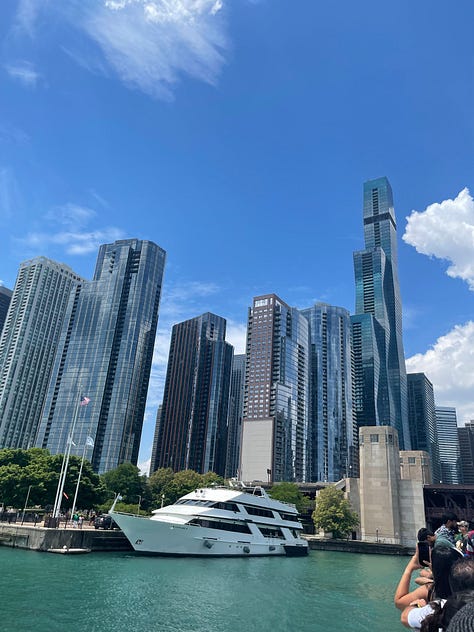
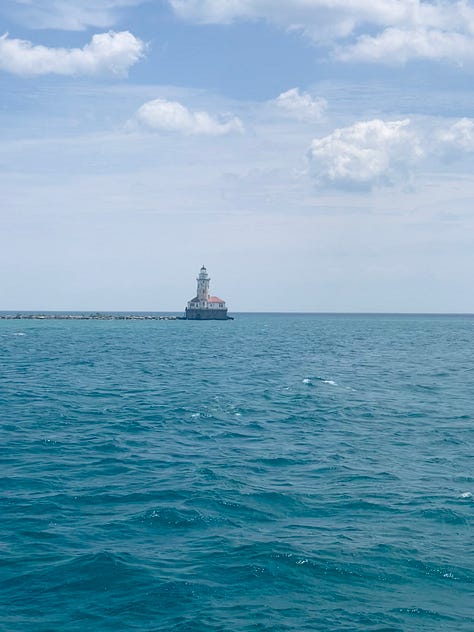
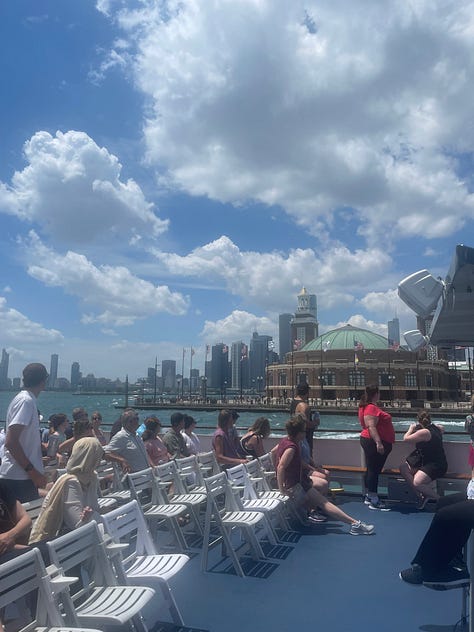
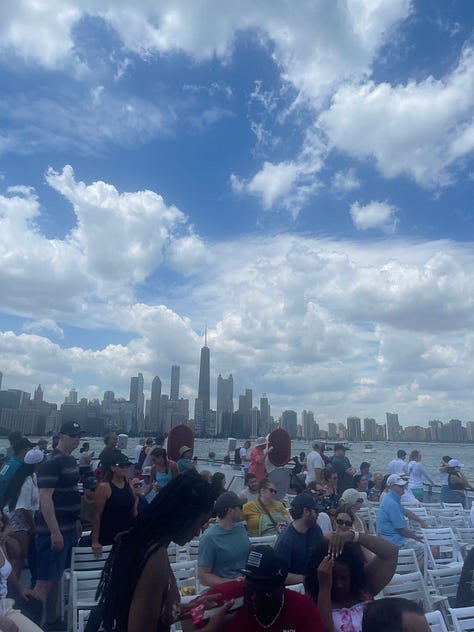
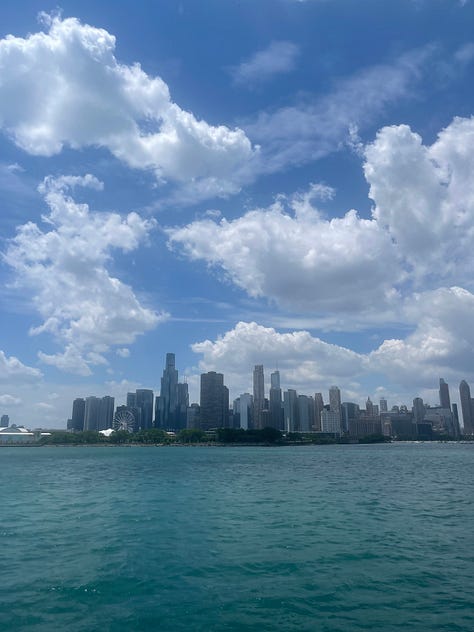
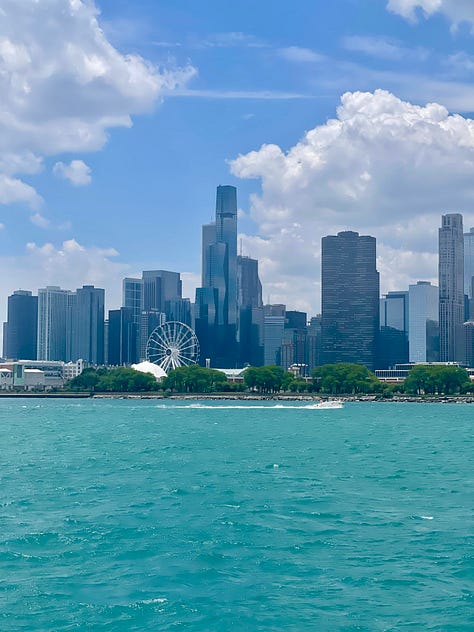
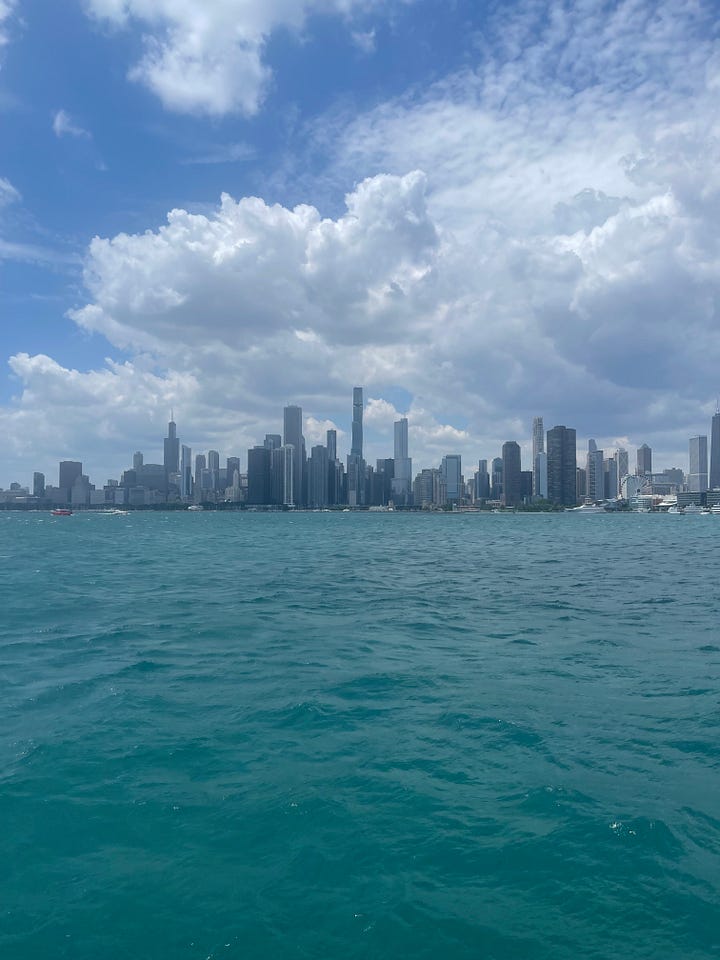

Malört Comes First, Wedding Magic Later
Let’s start with a little Chicago ritual called Malört. Imagine a drink that tastes like a mix of sweaty socks, metallic pine needles, and a splash of regret. I wisely opted out of trying it, but that didn’t stop me from thoroughly enjoying the wedding festivities, which were absolutely epic. I stayed up until 3 AM two nights in a row, and it was totally worth it!
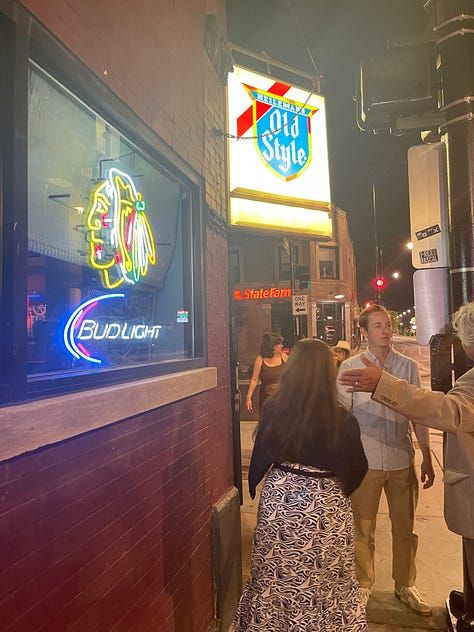

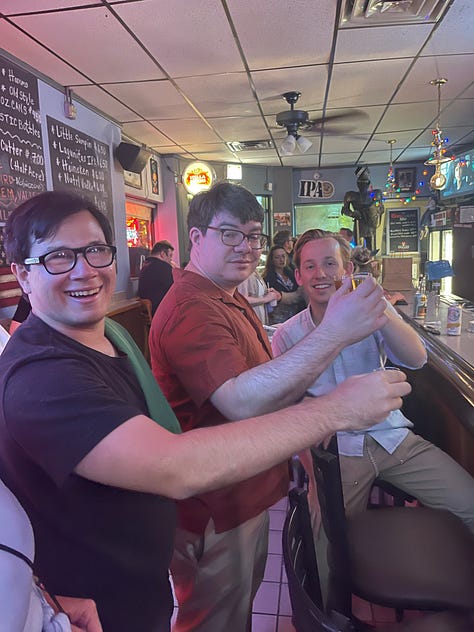
Speaking of epic, let me introduce my nephew, Andrew. He’s not just any PhD; he’s a particle physics whiz working at Fermilab, Vanderbilt University, and CERN in Geneva, Switzerland. Yes, you read that right—three major research institutions across the globe. Andrew’s work focuses on Supersymmetry and tau leptons, which are like the unicorns of particle physics. And the “Mrs. Melo”? She’s pretty epic as well. Congratulations!








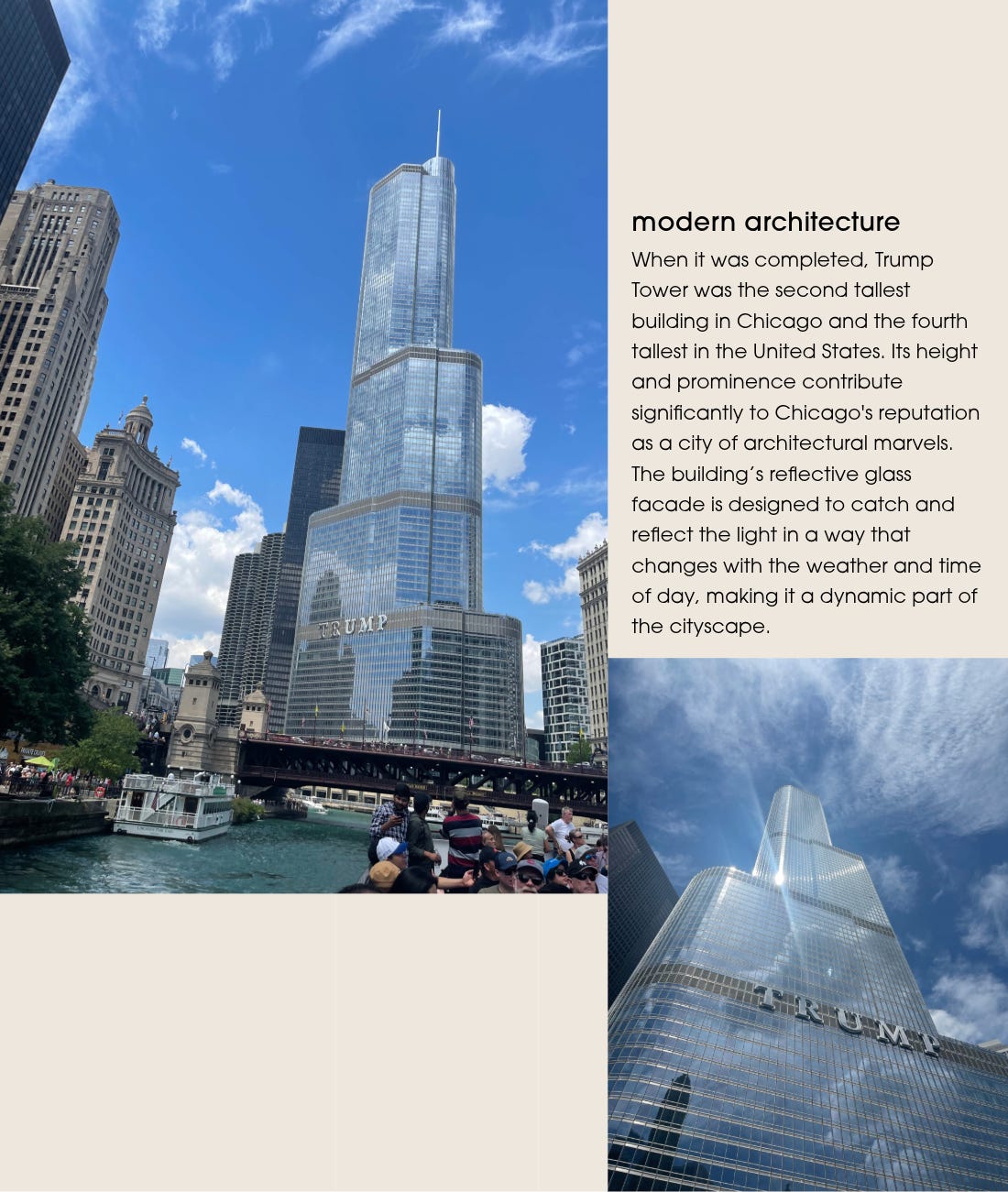



Another great article Lisa!
This is really interesting - I've always loved the Chicago skyline and the unique buildings. Now It's so great to know the history behind some of the most iconic architecture in the country - thank you for passing along your knowledge in such a fun read with beautiful photos. And what a perfect destination wedding for your nephew!